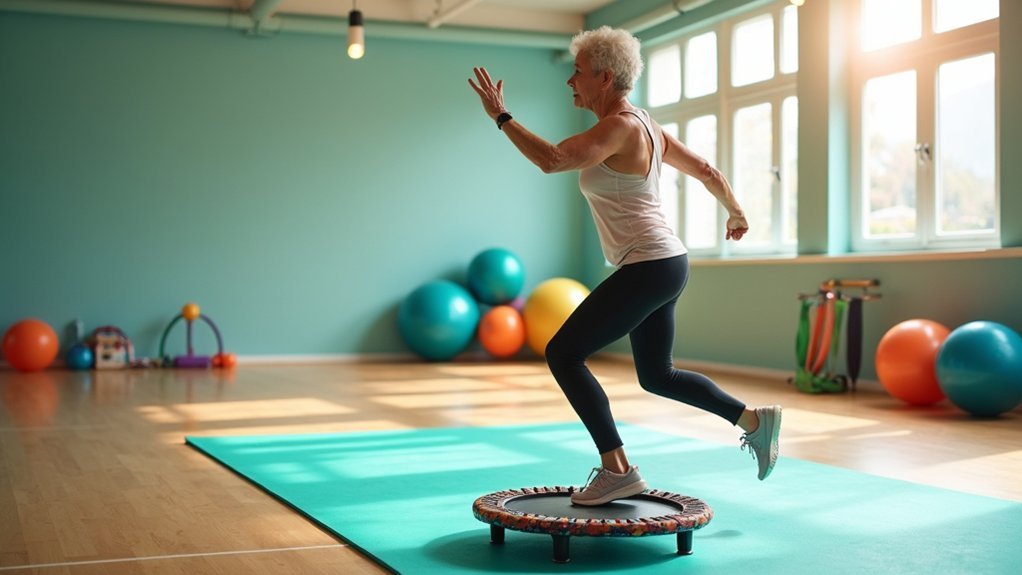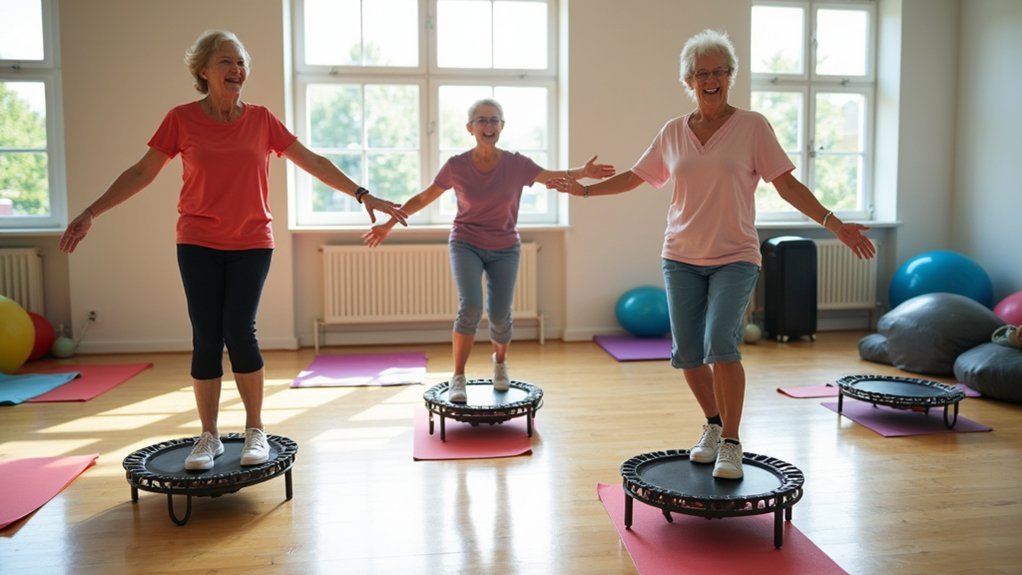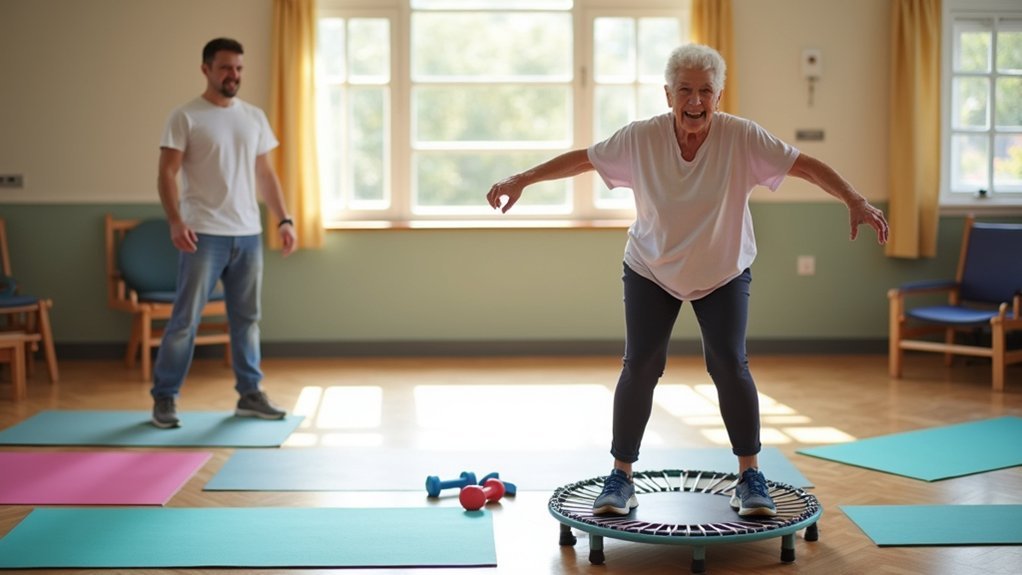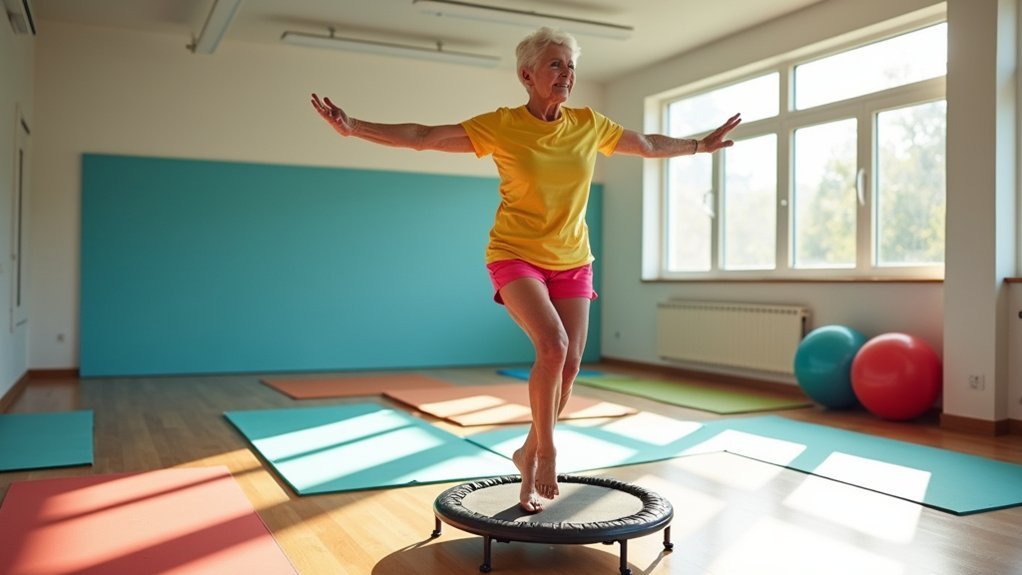Mini-trampoline (rebounding) workouts offer seniors a safe, effective way to improve balance by strengthening leg muscles and enhancing proprioception. Start with a handlebar-equipped model and basic exercises like gentle bouncing, heel-toe rocking, and mini-squats. Wear non-slip socks and maintain a micro-bend in your knees for safety. Begin with 5-10 minute sessions and gradually progress to more challenging movements. The combination of low-impact exercise and stability training creates meaningful improvements that translate to everyday activities.
The Science Behind Mini-Trampoline Balance Training

Why have mini-trampolines become a valuable tool in senior balance training? The answer lies in their ability to simultaneously strengthen key muscle groups while improving neuromuscular coordination.
When you bounce on a mini-trampoline, you’re actively engaging knee extensor and flexor muscles, which directly enhances your static and dynamic balance capabilities.
The unstable surface requires your body to constantly adjust, improving proprioception and reflexes. This challenges your central nervous system to develop better motor function and coordination responses.
Research shows mini-trampoline exercises can be as effective as resistance training for dynamic balance improvement, while also offering cardiovascular benefits like improved VO2 max. The reduced impact nature of mini-trampoline workouts makes them particularly accessible, with participants reporting an average RPE of 11.7 indicating a perceivably lighter intensity despite the effective workout.
The varied movements keep your mind engaged while your body works, creating an effective exercise environment that delivers measurable improvements in balance, strength, and mobility.
Getting Started: Safe Rebounding Practices for Seniors
When beginning mini-trampoline exercises, safety must be your top priority to prevent accidents while maximizing benefits. Always use a handlebar attachment and wear non-slip socks for stability. Select a low-height rebounder (under 10 inches) with proper spring covers to minimize risks. Maintain a micro bend in your knees and engage your core throughout all exercises.
Start with 5-10 minute sessions during your first two weeks, focusing on controlled movements with slightly bent knees and soft landings. Avoid twisting motions initially.
| Preparation Steps | Safety Measures |
|---|---|
| Get medical clearance | Use handlebar attachment |
| Complete 5-minute warm-up | Wear non-slip socks |
| Verify proper hydration | Keep knees slightly bent |
| Place rebounder on stable surface | Start with seated exercises |
Remember to stop immediately if you experience pain or dizziness. Progress gradually from seated positions to standing exercises with handlebar support.
Foundational Stability Exercises for Beginners

Four essential stability exercises create the foundation for any senior rebounding program.
Start with static stance drills by standing on the trampoline with feet hip-width apart, holding onto a handlebar while focusing on even weight distribution.
Begin your rebounding journey by mastering the basics: stand tall with balanced feet, grip the handlebar, and feel the stable surface beneath you.
Progress to heel-toe rocking, shifting weight between your heels and toes to improve ankle awareness and calf strength. Maintaining good posture during these exercises ensures proper form and maximizes stability benefits.
When you’re ready, try seated marches by sitting on the trampoline’s edge and lifting knees alternately to engage your core.
Finally, practice mini-squats with shallow knee bends (just 10-15° flexion) to strengthen your quadriceps with minimal joint stress.
Always wear non-slip footwear, limit initial sessions to 5-10 minutes, and use handlebar assistance until your balance improves.
Consider having a spotter nearby for added safety.
Progressive Balance Challenges to Build Confidence
Once you’ve mastered the foundation exercises, it’s time to gradually increase the challenge with more advanced balance training.
Progressive balance challenges not only reduce your fear of falling but also greatly improve your physical function and mental well-being.
On your mini-trampoline, try these confidence-building exercises:
- Dual-task bouncing – Toss a soft ball from hand to hand while maintaining a gentle bounce to improve cognitive-physical coordination.
- Multi-directional movements – Practice stepping side-to-side and front-to-back to enhance stability limits.
- Single-leg poses – Gradually work toward standing on one leg while holding the trampoline frame for support.
Incorporating these exercises into your routine can effectively address sensory impairments that naturally occur with aging, particularly in proprioception and vestibular function.
Remember to consult with your healthcare provider before advancing to these more challenging exercises, and always prioritize safety with proper supervision.
Combining Strength and Balance for Daily Function

You’ll get the most benefit when you integrate strength and balance training into everyday movements like standing from a chair or reaching for objects.
By practicing functional movement transfers with progressive resistance patterns, you’re building practical abilities that help maintain independence as you age.
Start with supported movements and gradually add more challenging variations to build confidence in your daily activities. Regular exercises can significantly reduce risk of falls, which is a leading cause of injury and death among seniors in Canada and North America.
Functional Movement Transfers
As we age, maintaining the ability to perform everyday tasks becomes increasingly important for independence and quality of life.
Functional movement transfers combine strength and balance exercises to mimic daily activities, enhancing your overall mobility while reducing fall risks.
Mini-trampolines offer an ideal low-impact environment for practicing these essential movements. They engage your core muscles while providing cardiovascular benefits that support functional fitness. For proper performance, always maintain a proud chest posture during each exercise to protect your spine and maximize stability benefits.
Try these effective functional exercises:
- Single-leg standing on the trampoline to improve stability and core strength
- Dual-task exercises like bouncing gently while counting backward to enhance cognitive-physical coordination
- Functional squats that simulate standing from a chair to build practical strength
Maintaining Independence Longer
The path to maintaining independence throughout your golden years begins with a strategic approach to physical fitness. Mini-trampoline training directly enhances your ability to perform essential daily activities through improved functional mobility and gait stability.
As your balance improves by up to 35% and your core strengthens, you’ll notice greater confidence in movement. This translates to reduced fear of falling and increased willingness to engage in daily activities.
The combination of strength and balance exercises creates practical benefits that extend beyond the workout itself. Regular rebounding engages multiple muscle groups which contributes significantly to overall functional strength in seniors. The social aspect of group training provides additional motivation to maintain consistent participation.
Progressive Resistance Patterns
Integrating progressive resistance training into your balance routine creates a powerful foundation for daily function and independence.
Combining strength work with mini-trampoline sessions targets both power and balance—crucial since power diminishes faster than strength as you age.
Focus on lower-body muscle groups that directly control your posture and stability.
For peak balance improvements:
- Start with 2-3 weekly sessions using moderate resistance (50-70% of your maximum) for strength, then incorporate low-load (20%) explosive movements for power.
- Prioritize multi-joint exercises like squats and lunges over isolation movements to mimic real-world movements.
- Progress gradually from stable surfaces to trampoline-based resistance exercises as your balance improves.
This dual approach enhances both static balance for standing and dynamic balance for movement. Research shows that Tai Chi programs can reduce the risk of falls by up to 55% when practiced consistently alongside resistance training.
Measuring Balance Improvements and Celebrating Progress
Monitoring progress stands at the heart of any effective senior balance training program. You’ll want to track improvements using standardized tools like the Berg Balance Scale (BBS), where scores above 45/56 indicate lower fall risk, or the Timed Up and Go (TUG) test, aiming for completion in under 12 seconds.
Celebrate meaningful milestones along your journey! A 5-point improvement on your BBS score correlates with reduced fall frequency, while achieving a TUG time of 10 seconds or less puts you on par with younger adults.
Success in dual-task exercises—like maintaining balance while counting backward—shows remarkable cognitive-physical coordination. Your progression from stable surfaces to mini-trampolines represents significant functional gains. Regularly practicing these exercises helps reduce fall risk for seniors, which is crucial given the statistics.
Don’t overlook subjective wins either—increased confidence in daily activities matters tremendously.
Frequently Asked Questions
Can Medication Side Effects Impact Mini-Trampoline Balance Training Results?
Yes, many medications can impair your balance during mini-trampoline workouts. Side effects like dizziness, drowsiness, and orthostatic hypotension from antidepressants, blood pressure medications, and sedatives directly affect your stability and coordination.
How Does Rebounding Compare to Tai Chi for Fall Prevention?
Both rebounding and tai chi effectively prevent falls. You’ll gain balance benefits from each, but tai chi requires no equipment and offers broader stability benefits, while rebounding provides controlled impact training you might enjoy more.
Are There Insurance Coverage Options for Prescribed Mini-Trampoline Therapy?
Yes, your insurance may cover prescribed mini-trampoline therapy. Private insurance, Medicare, and Medicaid often include it when it’s part of a documented physical therapy plan with proper medical documentation and prescription.
What Clothing and Footwear Are Optimal for Senior Rebounding Sessions?
Wear trampoline-specific socks with rubberized grips or lightweight flexible shoes with nonslip soles. Choose snug-fitting, moisture-wicking clothes without zippers. Don’t forget knee compression sleeves if you have arthritis or prior injuries.
Can Mini-Trampolines Be Effectively Used With Mobility Assistive Devices?
You can use mini-trampolines with mobility aids by adding stability bars for support. Consider specialized models with higher weight capacities and guarantee your device doesn’t interfere with proper positioning. Always have supervision initially for safety.
In Summary
You’ve now learned how mini-trampolines can transform your balance training journey. With consistent practice, you’ll notice improved stability, greater confidence, and enhanced daily mobility. Remember to progress at your own pace, combining strength and balance exercises for superior results. Track your improvements, celebrate small victories, and enjoy the bounce! Your commitment to trampoline stability workouts will continue to serve your independence for years to come.





Leave a Reply